No. 4 - TC-2 Starts Operations
The second spacecraft of Double Star Programme TC-2 was successfully launched from Taiyuan Satellite Launching Centre on 25 July 2004. The commissioning of both space and ground segments were performed from 27 July to 30 September. The Commissioning Review was held at Mullard Space Science Laboratory (UK) on 6-7 October 2004. The Review Board, consisting of members from the Chinese National Space Agency (CNSA) and ESA, examined the performance of the spacecraft, instruments and ground segment of the Double Star mission and declared TC-2 ready for the nominal operation phase.
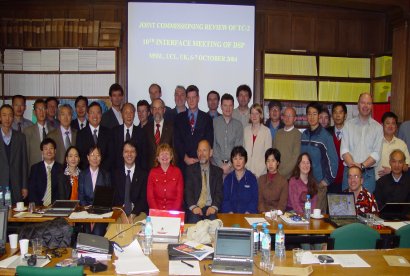 |
Spacecraft and Instrument Status
The spacecraft and all instruments are in good health and ready to return new observations to scientists. The two rigid booms were deployed nominally shortly after launch (change to different pyro actuators after one had failed on TC-1) and the magnetic interferences from the solar arrays are no longer present on TC-2, which confirms that the problems occurring on TC-1 have been solved. However, a few unexpected problems occurred in the early stage of the mission.
In the end of July 2004, soon after the launch, the near-Earth space environment became filled with very high fluxes of relativistic (>2 MeV) electrons for a period of almost two weeks; the peak electron fluxes were estimated to be the highest in 20 years. The cause was the fast solar wind streams that occurred during the period, which resulted in the magnetosphere producing high fluxes of "killer" electrons. These electrons can produce high charging levels in dielectrics inside the spacecraft, causing discharging events that can trigger a variety of problems to the payload and the satellite subsystems.
Both Double Star satellites cross the radiation belts twice per orbit; that is approximately twice a day for TC-1 and four times a day for TC-2. So, during the period of those two weeks several TC-2 instruments (as well as some on TC-1) experienced multiple resets. Luckily all the instruments survived, and the consequences of the resets were mainly data losses. Unfortunately, on the spacecraft side, both the main and redundant computers of the satellite attitude control system failed on TC-2.
The cause of these failures is still under investigation but severe space weather conditions are believed to play a role. As a result, a natural slow rotation of the satellite spin axis from its original position cannot be corrected. The attitude can still be determined, however, using a technique that is based on the magnetic field measurements collected around the perigee. The drift is observed to be exactly the same as predicted, but due to the failures the attitude cannot be changed any more if needed. Otherwise the spacecraft is in good health and these failures are not expected to have any major impact for the nominal duration (12 months) of the mission.
The TC-2 instruments are working nominally and return data as expected:
- Both instruments working well; FGM is a fluxgate magnetometer and LEFW is a search coil
- Magnetic interferences originating from the spacecraft are significantly less than those on TC-1, thanks to the successful improvements of the solar arrays done in the late spring
Magnetometers
FGM & LEFW- PEACE and LEID measure 3 dimensional particle distribution functions every 4 seconds
- NUADU detects energetic neutral atoms emitted from the radiation belts around the Earth; one image is produced every 1-2 minutes
- HEED, HEPD and HID measure fluxes of relativistic electrons and ions (both protons and heavier ions)
Particle Detectors
In general all instruments are working wellPEACE (electrons) & LEID (ions)
Science Results
NUADU
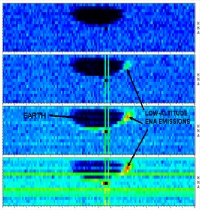 |
|
Figure 1a: NUADU data on 14 September 2004 at 12:19 UT |
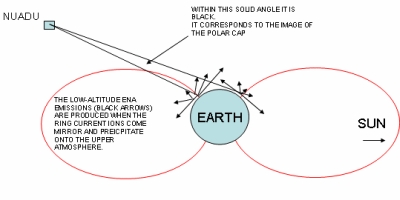 |
|
Figure 1b: Depiction of ENA Aurora |
PEACE
Figure 2 shows an example of PEACE electron data from 18 August 2004 during an outbound pass from perigee to apogee on the dayside magnetosphere. Around the perigee the instrument is off due to harmful effects of radiation belt particles. The plasma sheet and auroral zone are first detected, characterized by electrons with energies of 2-30 keV that have been accelerated in the magnetotail and that precipitate into the auroral region. Later the satellite is crossing the lobe, where the most tenuous plasma is found. The better understanding of the structure and dynamics of the plasmasheet and auroral zone is one of the major topics of the Double Star and Cluster missions.
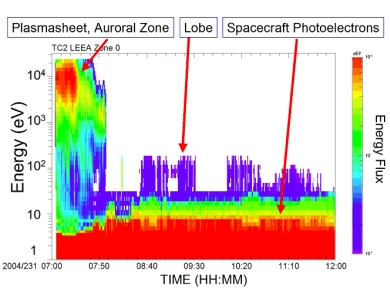 |
|
Figure 2: PEACE data on 18 August 2004. Energy-time spectrogram of electrons between a few eV up to 30 keV |
Cusp Encounter
Figure 3 shows magnetic field observations during a cusp encounter on 23 August 2004, 10:20-10:50 UT. The left-hand figure shows the TC-2 orbit across the northern cusp funnel; the Sun is to the left. The right-hand figure shows the three magnetic field components in GSE coordinate system and the total field at bottom. The measurements are dominated by the Earth's magnetic field but during the cusp encounter one can see variations in the By component which are caused by strong electric currents existing in the cusp. The cusp is the region where the solar wind particles can precipitate into the Earth's atmosphere. As electrons and ions move at different speeds, they cause electric currents as those observed in Figure 3. The structure and dynamics of the cusp is an active field of research in the Cluster community and the Double Star observations will add a valuable contribution to this effort. Scientists are looking for situations where both Cluster and TC-2 are in the cusp at the same time. Such events are expected to occur in the spring 2005.
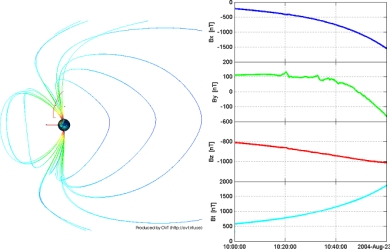 |
|
Figure 3: Magnetic field observations during a cusp encounter on 23 August 2004, 10:20-10:50 UT |
Ground Segment
The ground segment, which includes the Chinese stations in Beijing and Shanghai and the ESA ground station at Villafranca, has been tested and works as designed. Unfortunately the Beijing station had a failure on 21 August 2004 due to a lightning strike and has been non-operational since then. The other two stations, however, have been able to cover for the Beijing ground station, which is expected to be back in operations by the end of October. The three operation centres, the European Payload Operation System at RAL (UK), the Chinese Double Star Science Operation Centre and Double Star Operation and Management Centre are routinely operating both European and Chinese instruments. The European Data Disposition System at IWF (Austria) forwards raw data to the European users. Finally the Austrian, Chinese, French and United-Kingdom data centres have successfully exchanged and distributed preliminary science data.
Orbital Information
TC-2 is a polar-orbiting satellite (inclination of 90.1°) and currently its apogee is at an altitude of ~38 300 km over the north pole and its perigee at an altitude of ~680 km over the south pole. The orbital period is 11.5 hours during which it encounters several key plasma regions of the near-Earth space.
Future Activities
The handover ceremony from the satellite manufacturer, CAST (China Academy of Space Technology), to CSSAR (Center for Space Science and Applied Research) will take place in Beijing on 3 November 2004. This is followed by the IWG (Implementation Working Group) meeting on 4 November 2004 where various issues of the Double Star ground data systems will be discussed. On 5 November 2004 the SWT (Science Working Team) meeting takes place; in the meeting various scientific and technical matters on the Double Star observations will be discussed.
The next science event is the 2nd Double Star - Cluster Workshop, to be held in Beijing on 8-10 November 2004. At the conference new Double Star observations will be presented and will be compared with Cluster observations, particularly those made during conjunctions when the satellites are on the same magnetic field lines but at different distances from the Earth.
Contact points
Harri Laakso
ESA/ESTEC
Tel: +31-71-565 3319
Fax: +31-71-565 4697
Email: Harri.Laakso esa.int
esa.int
C. Philippe Escoubet
ESA/ESTEC
Tel: +31-71-565 3454
Fax: +31-71-565 4697
Email: Philippe.Escoubet esa.int
esa.int
Bodo Gramkow
ESA/ESTEC
Tel: 31-71-565 4564
Fax: 31-71-565 5922
Email: bodo.gramkow esa.int
esa.int


